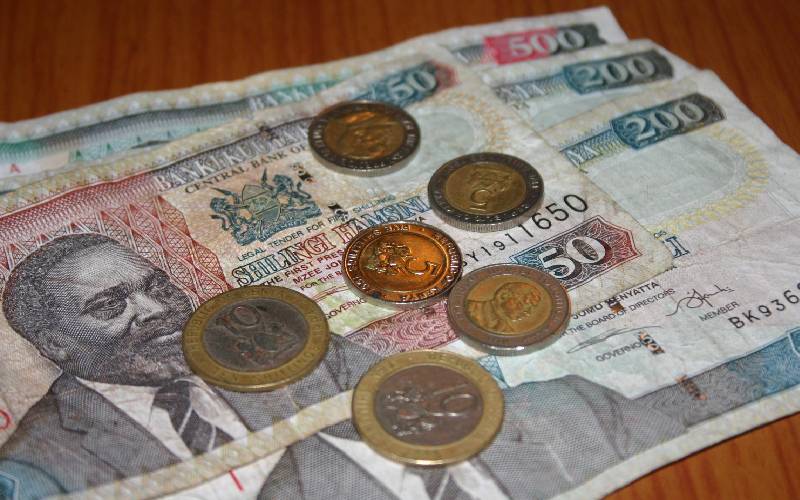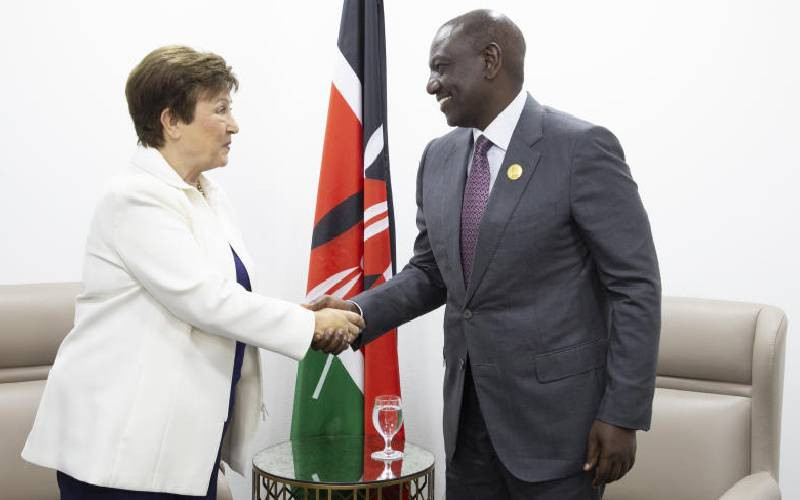
How the shilling has defied economics to remain strong against the dollar among other major currencies remains a mystery that has baffled many.
It has confounded economics who were pessimistic that the local unit would weaken even as Kenya faces huge dollar debt payments.
And in the analogy of mangoes, which are in plenty this season, their huge supply has driven down prices. Even those who would not necessarily want mangoes are tempted to blend their juice.
The forces of demand and supply in the market also explain the prices of currencies. Few dollars in the market call for one to use more shillings to buy the greenback - the standard unit used in the global export and import market.
So when the shilling strengthened to 99 units per dollar this year, analysts quickly tried to understand why the forces of demand and supply had changed, had a mango season suddenly crept up on us without having noticed?
This happened at a time when most currencies were losing ground against the greenback - making the shilling the unique and odd one out that was outperforming peers, including other better currencies.
The shilling has been so rigid to the extent that monumental events that occurred in the country seemed not to bother it. The two significant events recently-- the Dusit D2 attack in Riverside, Nairobi and the questioning of Finance Cabinet Secretary Henry Rotich by anti-graft sleuths-- have had little or no effect on Kenya’s ‘invulnerable’ currency.’
In fact, at the time of the terror attack on an upmarket shopping complex, the Kenyan shilling actually gained against the dollar. Despite the attack on Dusit Hotel complex, the shilling traded at 101.7 against the dollar. Analysts say the currency will stay put even when global growth dims as talk of recession troubling the global economy increases.
When CS Rotich was extensively grilled for four consecutive days over the Arror and Kimwarer dams scandal, it was widely expected that the uncertainty surrounding his tenure in light of the latest corruption scandal to rock the Jubilee government would send jitters in the market as well as the performance of the shilling.
But in the days trading, investors gained Sh181 million in paper wealth as stock market capitalisation moved up cautiously to Sh2.301 trillion - riding on banking shares, which moved 54.9 per cent of the day’s traded value as focus shifted to the announcement of full-year results. The shilling also remained stable, with commercial banks quoting the local currency at 100 per dollar, and forecast to strengthen due to inflows from horticulture exports and remittances.
The summoning of Treasury boss came at a time when CS Rotich was more worried about the country’s spiraling debt as the country faces over Sh200 billion maturing foreign currency loans with refinancing having a direct impact on the status of the shilling.
“The steady rise in foreign inflows into the country combined with weaker demand for the dollar on account of suppressed manufacturing sector imports is expected to continue supporting the shilling’s performance in the short term,” Apex Capital researcher Harisson Gitau said.
“However, increased borrowing, a weakening manufacturing sector coupled with instability in global financial markets remain key threats to the shilling.” The currency market is mainly affected by imports and exports. If you import more, you need more dollars, which becomes expensive. If you export more, you earn more dollars.
You do not have to go looking for them and dollars become cheap. So did import-export trade change drastically and earn the country extra dollars to offset demand for the American forex.
Stay informed. Subscribe to our newsletter
Cut flowers
According to CBK data, dollars from exporting tea was $1.407 billion (Sh140 billion), in the 12 months to November 2018, up from $1.398 billion (Sh139 billion) in 2016. Horticulture was up from Sh82 billion ($819 million) in 2017 to 96.6 billion ($966 million) by the end of last year, comprising of cut flowers Sh113.16 billion, fruits Sh12.83 billion and vegetables Sh 27.68 billion.
However, coffee earnings declined from Sh23.5 billion ($235 million) to Sh23.1 billion ($231) million during the same period.
“The cut-flower export still remains the largest horticulture earner, contributing 74 per cent of the total fresh produce annual earnings, fruits at eight per cent and vegetables at 18 per cent,” Chief Executive Officer of Fresh Produce Exporters Association of Kenya Hosea Machuki said.
Despite insisting on liberal policies that allows the market forces to determine the price of the shilling, Kenya’s Central Bank Governors are often under implicit pressure to keep the currency strong.
In November 2011 a Parliamentary Committee even proposed the removal of Prof Njuguna Ndung’u, from the CBK when the shilling plummeted from about Sh75 to Sh107 against the US dollar.
When CBK Governor Patrick Njoroge inherited the shilling, the market tested him tumbling the shilling towards this psychological mark only to have him arrest the fall and orchestrate market discipline that has kept the shilling stable to date.
Analysts have ruled out that there was a magic export that had suddenly helped Kenya earn more dollars and that such a monumental export shift still hangs on the hope of exporting the much-hyped Turkana crude oil.
The only explanation would be that if the inverse is true, we are importing fewer products hence we do not need to buy dollars, therefore, lower demand.
Some analysts concurred, noting that lower export demand may actually explain the strengthening of the shilling. “We saw significant inflows over the Valentine season, horticulture has been the main driver supporting forex in the last couple of months,” said Jibran Qureishi, economist for East Africa at Stanbic Bank
“On the demand side there is not too much dollar demand, it has been quite in the import market front. Importers are not capitalising on lower spot prices to build reserves. The stability has encouraged a lot of calm so importers are not worried of shocks down the road,” he said
Bernard Kiarie of African Alliance said lower import demand, oil prices, and higher inflows have helped prop up the shilling as the macros have been very good. However, CBK monthly data seems to suggest the opposite - showing that imports by December 2018 had actually gone up from Sh1.6 trillion ($15.9 billion) to Sh 1.63 trillion ($16.3 billion).
Only food imports declined from Sh220 billion ($2.2 billion) to Sh170,000 ($1.7 billion), transport machinery by Sh8.1 billion ($81) million and Machinery from Sh300 billion ($3 billion) to Sh290 billion ($2.9 billion.) Petroleum, on the other hand, shot up from Sh260 billion ($2.6 billion) to Sh340 billion ($3.4 billion). Chemical imports were up by 23.5 billion ($235 million) and manufactured goods went up from Sh 250 billion ($2.5 billion) to Sh290 billion) $2.9 billion.
Indeed, Kenya as a net importer country was actually buying more goods than last year, which means demand for the dollar should have caused the shilling to move in the opposite direction.
It has been suggested that other than exports, diaspora dollars from Kenyan living abroad may be the surprise culprit.
ApexAfrica Capital Research said Kenya’s current account deficit shows the import-export gap narrowed further in January as receipts from agriculture, tourism, and diaspora remittances outpaced import growth.
The Central Bank of Kenya (CBK) data shows that the deficit as a percentage of GDP stood at 4.6 per cent at the end of January, compared to 4.9 per cent at the end of December 2018.
Both tourism and diaspora remittances returned record inflows in 2018, with the dollars earned also backing the shilling to retain the upper hand against the dollar going into this year. “The shilling’s gains against the dollar in recent months may be attributed to increased remittances, increased output in the local agricultural industry and the uncertainty in the US economy surrounding the ongoing trade deal talks with China,” Gitau said.
“A strengthening shilling is expected to boost foreign investors’ earnings at the bourse, since they stand to gain from shilling to dollar currency conversions.”
Indeed Kenya did receive substantial flows of dollars from the diaspora and foreign direct investment. But are these two factors enough to make such a tow on the shilling? Kenya’s biggest foreign currency earners are the Kenyans in the diaspora who send back more money.
The diaspora population estimated at three million remitted cumulative inflows of up to $2.697 billion (Sh274.2 billion) to December last year from $1.947 billion (Sh197.9 billion) in the 12 months to December 2017, reflecting a 39 percent growth.
This means that Kenyans living and working abroad sent home about Sh100,000 each, making diaspora cash the country’s top dollar earner, almost catching up with total exports, which stand at $4.9 billion (Sh490 billion).
Another source of dollars is foreign investments in Kenyan companies. Among notable portfolio investments were French downstream fuel industry group, Rubis Energie, bought KenolKobil in a Sh36 billion transaction, making it the largest foreign direct investment deal in recent years.
Private equity firms AfricInvest and Catalyst Principal Partners also acquired a minority stake in Prime Bank through injection of Sh5.1 billion capital into the lender.
However, I&M Burbidge says that compared to last year, the level of private equity activity has not been as high which means that comparatively, the currency is not getting help from FDI. “In February 219, a slower pace in deal activity was recorded in the East African region with only two deals having been disclosed during the month compared to the six deals disclosed in February 2018 and the record 15 deals in January 2019,” Edward Burbidge and Linda Obwora said.
Some observers have also posed a theory that CS Rotich’s tax amnesty and criminal pardon for those who had kept money outside the country may explain the rise in diaspora remittances and as such the strengthening of the shilling. The Stanbic Economist, however, disputes this pointing out that last year when the amnesty was announced, significant money did flow into the country but the shilling did not rally then.
“Rotich amnesty may not explain the current trend... it happened in a big way last year but it is not as steep this year,” Qureishi said. Institute of Economic Affairs Chief Executive Kwame Owino said the story of remittances has to be viewed with retrospect to the region where the rest of the East African countries have also been getting more money from citizens abroad yet their currencies still depreciated.
“CBK says we have to take into account the fact that diaspora remittances have gone up significantly by over Sh200 billion ($2 billion), however, while this is significant it is not so much since we have been averaging about Sh130 billion ($1.3 billion) to Sh150 billion ($1.5 billion) a year,” Mr Owino said.
“If we also look at the story about remittances vis a vis our neighbours, their own remittances are not as big but are sizable in relation to their economic sizes. This seems to suggest that the strengthening cannot be explained by remittances,” he said.
When we posed the question to the Central Bank of Kenya to try and point us in the right direction, our query was rebuffed by a generic market response. “The CBK’s policy is clear and has not changed: we have a flexible exchange rate policy, and the CBK only intervenes to minimise volatility,” CBK said.
In fact, CBK has actually been buying dollars to keep up an illusion of demand so that the dollar reserves don’t fall further while the apex bank stockpiles its reserve ammunition for a rainy day.
“The shilling is the strongest since early 2015, in fact, the shilling could be stronger it’s just that the CBK is buying dollars. It is taking the opportunity to build its reserves, if not the currency would be about 98 units for the dollar,” said Jibran Qureishi.
Last week’s forex reserves were the highest this year at Sh840 billion ($8.392 billion) from a low of Sh800 billion ($7.93 billion) at the beginning of the year. Off the record, most analysts say it is the CBK that is literally controlling the shilling supported by favourable macroeconomics.
Kenya has been cagey about the currency has given the rise of foreign borrowing which means that for every dollar we borrowed, we need more shillings to pay back if the currency depreciates. “On debt with the balance of debt tipping to external where we owe foreign governments and institutions which need to be paid in dollars if the shilling depreciates significantly there will be implications,” Owino said.
They mirror the Bretton Woods institution International Monetary Fund (IMF) which last year said the shilling risked being classified as “managed” rather than operating on the forces of demand and supply.
“Reflecting limited movement of the shilling relative to the US dollar, Monetary and Capital Markets Department 2018 report on exchange rate arrangement to be published in February 2018 will reclassify Kenya’s shilling from floating to other managed arrangement,” said IMF.
The Institute of Economic Affairs said they had done a comparative review which concurred with the assertion that the shilling was disjointed from market fundamentals.
“Here at the IEA, we believe the shilling is too strong. We usually look at two benchmarks, one which is basically imports vs exports, what we call trade balance. The imports are getting bigger while exports have not risen as much,” IEA boss Owino said
“If we also benchmark it against the regional currencies, most have depreciated by about 10 per cent over the last three years yet the Kenyan shilling has strengthened, what is so peculiar about us,” he said. IEA warned that the lull was not sustainable as whenever the shilling stayed flat for too long, it also fell more aggressively.
“We also followed a record over 25 years of shilling depreciation in history and found that the Kenyan currency tends to stay strong for long periods while depreciations are big about eight to nine per cent,” he said.
Brutal fashion
Debt expert Deepak Dave of Riverside Capital also sounded a warning that the shilling’s strength could unravel fast and urged CBK to prepare to deal with such an eventuality.
“Its good from inflation and debt servicing perspective. Unfortunately, markets have a way of imposing the reality of fundamentals in a brutal fashion. When that happens we have to hope CBK are ready to deal with the consequences,” Deepak said.
“Now would be the time for reserves to be padded up, Treasury to make advance debt payments or redemptions and importers to build stocks. We will only know if this all happened three or so months from now,” He said.
CBK would be hoping that if such a threat lay in the foreseeable future, the National Treasury would have negotiated with the IMF for a stand by the facility, giving the shaky confidence in the currency a much-needed back-up.
The strong shilling has also made Kenya’s exports uncompetitive regionally.
“The effects are very clear, we saw for the first time in a long while that Uganda exported more to Kenya in the last quarter of 2018, part of which had to do with the shilling. When the shilling is too strong our exports to Tanzania and Uganda cannot be competitive,” Owino said.
 The Standard Group Plc is a
multi-media organization with investments in media platforms spanning newspaper
print operations, television, radio broadcasting, digital and online services. The
Standard Group is recognized as a leading multi-media house in Kenya with a key
influence in matters of national and international interest.
The Standard Group Plc is a
multi-media organization with investments in media platforms spanning newspaper
print operations, television, radio broadcasting, digital and online services. The
Standard Group is recognized as a leading multi-media house in Kenya with a key
influence in matters of national and international interest.
 The Standard Group Plc is a
multi-media organization with investments in media platforms spanning newspaper
print operations, television, radio broadcasting, digital and online services. The
Standard Group is recognized as a leading multi-media house in Kenya with a key
influence in matters of national and international interest.
The Standard Group Plc is a
multi-media organization with investments in media platforms spanning newspaper
print operations, television, radio broadcasting, digital and online services. The
Standard Group is recognized as a leading multi-media house in Kenya with a key
influence in matters of national and international interest.









